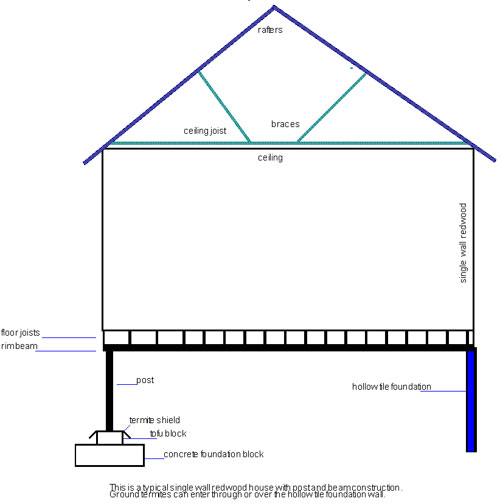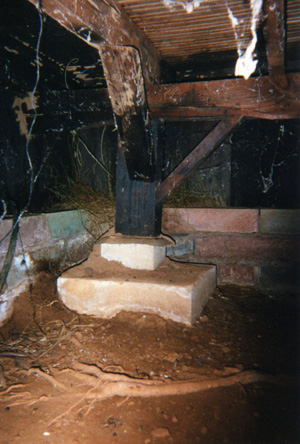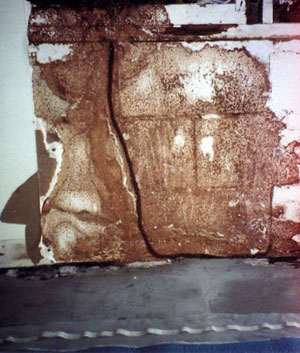| GROUND TERMITES
SENTRICON
Traditionally, in the effort to keep ground termites out
of a structure, a combination of physical barriers, (termite shields,
Basaltic Termite Barrier, Termimesh, etc.) and termiticides were
the only choices available. These were strictly defensive measures
in that they hindered the access of ground termites into a structure.
In 1994 this changed when Dow-AgroSciences introduced the SENTRICON
termite baiting system. Briefly this works by placing bait stations
with wood in them in the ground around a structure. When ground
termites find one or more stations the wood is replaced with sawdust
impregnated with an chitin synthesis inhibitor , hexaflumuron. The
worker termites feed on this and in turn feed it to the rest of
the colony. This is not a toxicant but an insect growth regulator
which prevents young termites from molting their skin and consequently
becoming adult worker termites. The number of adult workers declines
due to natural attrition and there are no replacements. Consequently,
the colony dies or its numbers are reduced to the point that it
is no longer a threat to nearby structures. For the first time ever
the termite companies now have an offensive weapon. This has been
shown to be a very effective way to control ground termites and
should be a serious consideration for every homeowner particularly
those whose homes have had ground termite infestations in the past.
TERMIDOR
Termidor is a liquid insecticide that is applied to the soil
around and under a structure. It utilizes a unique action known
as the "Transfer Effect™" to effectively control
termite colonies. Termidor does not repel termites - termites can't
smell, see or feel the insecticide, so they crawl freely through
treated areas. When a termite eats or even comes in contact with
the insecticide, it unknowingly transfers Termidor back to the colony
on its body. Every termite it contacts will transfer Termidor's
active ingredient, fipronil, to other termites.
SUBTERRANEAN TERMITES

Post and beam construction, property done as shown in the diagram above, generally offers good protection against ground termite infestation. Only rarely will the ground termites build their mud tubes over the foundation and metal termite shield. This photo shows below an exception. All of the dirt visible in the photo is a massive termite tube that leads up to the post supporting the house. From this entry point they infested and severely damaged almost the entire structure including the floors and walls. The house had to be razed as it was not salvageable.

Hollow tile foundations are probably the most vulnerable. This photo below demonstrates this. At one time this was a covered lanai with a low hollow tile wall. Wood framing was added to the top of the wall and the exterior covered with siding and the interior with sheetrock. Ground termites entered through the hollow tile behind the sheetrock and severely damaged the framing inside the wall. They had been in here for months or even years without a trace until the carpet was pulled back. Both situations show why it is important to treat for the prevention of ground termites in Hawaii.


Many of the homes built since the late 1950ís have a concrete slab-on grade foundation. These are much more vulnerable to ground termite infestation as there is little in the way of a physical barrier to keep termites out. This type of construction was made possible by chlorinated hydrocarbon insecticides such as aldrin, dieldrin and chlordane that were developed during World War II. These were toxic and persistent compounds that could be applied prior to pouring the concrete then reapplied about every five years. The weak spot is the perimeter of the house where new soil eventually accumulates against the siding or shrubs are planted and that breaks the insecticide barrier. Frequently additions are made to the house and the insecticide barrier is broken and no new insecticide applied.
|









